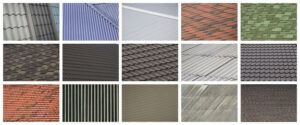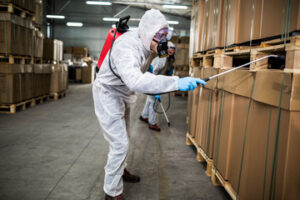A roof is a crucial component of any building, protecting the interior and exterior from harsh weather conditions. It can also add curb appeal and increase the value of a home or business.
Understanding different Corpus Christi Roofing materials can help you choose a sturdy, durable option that fits your design aesthetic and climate. This Roofing Materials: A Beginner’s Guide will help you make that decision.

Asphalt
The most common roofing material is asphalt shingles. This is a result of their versatility, affordability, and weather resistance. The roof is one of the most important parts of a home, so it must protect everything beneath it from the elements. Asphalt shingles do this effectively, and are also easy to install and come in a variety of styles that complement different architectural styles.
There are three basic types of shingles: regular, 3-tab, and dimensional. Regular shingles have three regularly spaced tabs, which gives them a uniform look that suits many homes. 3-tab shingles are the least expensive of the three options, but they are also the thinnest and offer the lowest durability. They may last for several decades, but they are not the best option in areas that experience severe weather.
Another significant advantage of asphalt shingles is their wide range of colors. For homeowners looking to preserve their curb appeal or make their homes look better before selling, the ability to choose a color that complements the rest of the house is very helpful. Many other roofing materials do not offer as many choices in terms of color.
Unlike the petroleum-based asphalt used in road construction, roofing asphalt is processed to create an extremely tough material that resists moisture and can protect a home for years. In addition to asphalt, shingles contain a fiberglass mat that is then covered with mineral granules that protect against the elements and UV rays.
Several components go into making a roof, including underlayment, ice and water shields, starter strips, and flashing. The underlayment acts as a barrier to prevent the penetration of water, while ice and water shields help keep snow from melting underneath the shingles and causing damage. Flashing helps to seal the seams and gaps between shingles, as well as around any pipes or vents that are installed on the roof.
When it comes to choosing a roof, the most important metric is durability and weather resistance. Asphalt shingles are a great choice because they are very durable and can withstand a variety of weather conditions, from snow to high winds. They are also fire-resistant, and some types can even withstand class-A wildfires.
Wood
The roof is one of the most important components of a home, providing protection from harsh weather conditions and contributing to its overall look. However, it doesn’t do its job alone. It is supported by a network of layers and critical accessories that help to keep the structure safe, sound, and energy efficient.
There are many different roofing materials on the market today, each with its advantages and disadvantages. The best choice for your home depends on your preferences, budget, and climate.
Wood shingles and shakes provide a natural aesthetic, while also being a durable, long-lasting option. They are available in a variety of colors and can complement any architectural style. However, they are not recommended for areas prone to heavy rains or wildfires because they are vulnerable to water damage and can develop algae and fungi.
Cedar shingles are the most common type of wood shingle, as they are highly moisture-resistant and will not rot. Redwood is another popular choice, but it isn’t as readily available and can be more expensive than cedar. Yellow pine and cypress are less expensive options, but they require special treatments to prevent damage from the elements.
Shakes are generally hand-split, which gives them a rugged appearance. They are available in several styles, each with a unique texture and appearance. In general, shakes are split to leave one side rough and textured, while the other is smooth and facing downward. Shingles, on the other hand, are machine-sawn, with cuts varying from being along the grain to against it.
Regardless of the type of shake or shingle you choose, a proper roof installation is essential to ensure long-lasting performance. The first layer is a roof deck, which is typically made of plywood or oriented strand board (OSB). It provides the base for the other layers and supports the weight of the roofing material.
Several other roofing materials can be used to protect a building from the elements, including slate, clay, and concrete tiles. Slate is one of the longest-lasting roofing materials, offering a lifespan of up to 100 years. It is highly durable, but it’s also one of the most expensive and requires skilled labor to install.
Metal
Metal roofing has been used for commercial roofs for years but is gaining popularity for residential use as well. It has longevity, durability, and looks that appeal to many homeowners. It is also relatively affordable compared to other types of roofing.
The different types of metal used for roofing include steel, aluminum, and zinc. Each one has its characteristics that affect its strength and appearance. Aluminum is lightweight and corrosion-resistant. It is a good choice for areas that experience high winds because it can withstand up to 140 mph. Steel is durable and rust-resistant, but it can be quite heavy and requires proper installation to avoid structural damage.
Zinc is an eco-friendly option that is very long-lasting and corrosion-resistant. However, it is more fragile than other types of metal roofing. It can also rust easily if exposed to water for extended periods.
Copper is an alternative metal that is becoming increasingly popular for home roofs. It develops a natural patina that some people enjoy, but others may not. It is expensive and can corrode quickly if exposed to water.
Tin was once a popular roofing material, but its popularity started to decline over a century ago as aluminum was introduced. Tin is lightweight and rust-resistant, but it can dent quite easily. It is also prone to expansion and contraction, so installers need to leave plenty of room for it to expand and contract without damaging the panels or creating leaks.
Other metals are used for roofing, such as stainless steel and galvanized steel. Galvanized steel has a protective layer of zinc that helps extend its life. Stainless steel is more durable than galvanized steel, but it can be quite expensive. Copper is another alternative that can be very attractive, but it does require a lot of maintenance to keep it in pristine condition. It can also rust if exposed to water for prolonged periods, and it can stain siding, brick, or concrete. These are just some of the options for metal roofing materials, but there are many other alternatives as well.
Tile
Tile is an architectural roofing material that adds to the visual appeal of a building. It’s available in a wide range of styles and colors, and it can complement any architectural design. It can also be made from natural materials, such as slate or clay. Choosing the right roofing material for your roof depends on several factors, including your budget, your home’s architecture, and the climate in which you live.
The most common type of roof tile is the asphalt shingle, which can be found in many homes. These are a low-cost option that offers good durability, especially in moderate climates. They’re also fire-resistant and come in a variety of styles, including three-tab, architectural, and designer shingles.
Another popular roofing material is clay tile, which comes in a wide range of colors and shapes. It’s durable, energy-efficient, and can resist harsh weather conditions, such as hail storms. It’s also an eco-friendly choice because it reflects sunlight, which lowers the interior temperature of your home.
Slate tiles are another premium roofing material that can last up to 100 years. They’re highly resistant to extreme weather conditions, such as hail, and they aren’t prone to biological buildup like mold and moss. However, they can be very heavy and may require a sturdy structure to support them.
Regardless of which type of roof tile you choose, it’s important to use a high-quality underlayment. This is necessary to prevent water damage and prolong the life of your roof. The underlayment should be a minimum of two layers of No. 30 felt with a minimum overlap of 2 inches on horizontal joints and 6 inches on end laps. It should also extend over the hips and ridges of the roof. Once the underlayment is installed, you can install the roof tiles. When installing tile, it’s recommended that you start at the eaves and work your way up to the center line of the gutter. When laying the tiles, make sure that they’re properly overlapped and spaced evenly. After the tiles are installed, you can install ridge tiles to the top of the roof.
